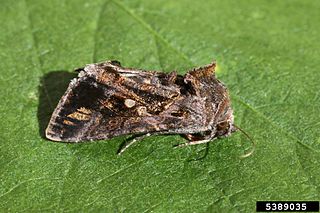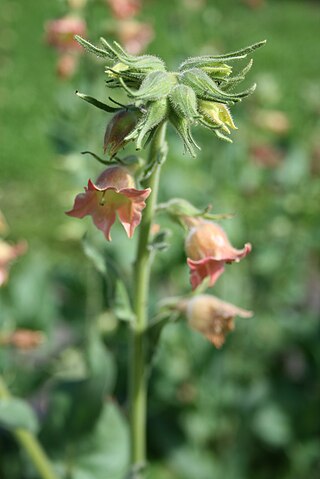
Nicotiana is a genus of herbaceous plants and shrubs in the family Solanaceae, that is indigenous to the Americas, Australia, Southwestern Africa and the South Pacific. Various Nicotiana species, commonly referred to as tobacco plants, are cultivated as ornamental garden plants. N. tabacum is grown worldwide for the cultivation of tobacco leaves used for manufacturing and producing tobacco products, including cigars, cigarillos, cigarettes, chewing tobacco, dipping tobacco, snuff, and snus.

Nicotiana glauca is a species of flowering plant in the tobacco genus Nicotiana of the nightshade family Solanaceae. It is known by the common name tree tobacco. Its leaves are attached to the stalk by petioles, and its leaves and stems are neither pubescent nor sticky like Nicotiana tabacum. It resembles Cestrum parqui but differs in the form of leaves and fusion of the outer floral parts. It grows to heights of more than two meters.

Nicotiana sylvestris is a species of flowering plant in the nightshade family Solanaceae, known by the common names woodland tobacco, flowering tobacco, and South American tobacco. It is a biennial or short-lived perennial plant in the tobacco genus Nicotiana, native to the Andes region in Argentina and Bolivia, in South America.

Nicotiana rustica, commonly known as Aztec tobacco or strong tobacco, is a rainforest plant in the family Solanaceae. It is a very potent variety of tobacco, containing up to nine times more nicotine than common species of Nicotiana such as Nicotiana tabacum. More specifically, N. rustica leaves have a nicotine content as high as 9%, whereas N. tabacum leaves contain about 1 to 3%. The high concentration of nicotine in its leaves makes it useful for producing pesticides, and it has a wide variety of uses specific to cultures around the world. However, N. rustica is no longer cultivated in its native North America, as N. tabacum has replaced it.
Pituri, also known as mingkulpa, is a mixture of leaves and wood ash traditionally chewed as a stimulant by Aboriginal Australians widely across the continent. Leaves are gathered from any of several species of native tobacco (Nicotiana) or from at least one distinct population of the species Duboisia hopwoodii. Various species of Acacia, Grevillea and Eucalyptus are burned to produce the ash. The term "pituri" may also refer to the plants from which the leaves are gathered or from which the ash is made. Some authors use the term to refer only to the plant Duboisia hopwoodii and its leaves and any chewing mixture containing its leaves.
Nicotiana africana is a species of plant in the family Solanaceae. It is endemic to Namibia. Its natural habitats are subtropical or tropical dry shrubland and rocky areas.
Mark Wayne Chase is a US-born British botanist. He is noted for work in plant classification and evolution, and one of the instigators of the Angiosperm Phylogeny Group-classification for flowering plants which is partly based on DNA studies. In particular he has researched orchids, and currently investigates ploidy and hybridization in Nicotiana.
Nicotiana tomentosiformis is a perennial herbaceous plant. It is a wild species of tobacco native to the Yungas Valley region in the eastern piedmont of the Andes Mountains, primarily in Bolivia.
Nicotiana otophora is a perennial herbaceous plant. It is a wild species of tobacco native to the Andes Mountains of Bolivia and Argentina.

Chrysodeixis includens, the soybean looper, is a moth of the family Noctuidae. It is known as falso medidor in north-eastern Mexico. It is found from southern Quebec and southern Ontario through the eastern and southern part of the United States to Central America and South America, the Antilles and the Galápagos Islands. It is known to be migratory. The species was first described by Francis Walker in 1858.

Dr Maarten Joost Maria Christenhusz is a Dutch botanist, natural historian and photographer.

Psychoactive plants are plants, or preparations thereof, that upon ingestion induce psychotropic effects. As stated in a reference work:
Psychoactive plants are plants that people ingest in the form of simple or complex preparations in order to affect the mind or alter the state of consciousness.

Nicotiana langsdorffii, Langsdorff's tobacco, is a species of flowering plant in the nightshade family Solanaceae, native to Brazil. Growing to 1.5 m (4.9 ft) tall by 0.5 m (1.6 ft) broad, it is an annual plant with large sticky leaves up to 10 in (25 cm) long. It bears 2 in (5.1 cm) long, nodding, tubular bell-shaped flowers that are apple green in colour, with blue anthers. N. langsdorfii lacks fragrance, unlike some of the other tall species. It is grown as an ornamental garden plant.

Nicotiana glutinosa is a species of tobacco plant that is economically important in tobacco hybrids. N. glutinosa is native to western South America, including Bolivia, Ecuador, and Peru. It is a model organism for the study of Tobacco mosaic virus resistance in tobacco.

The Solanaceae, or the nightshades, are a family of flowering plants that ranges from annual and perennial herbs to vines, lianas, epiphytes, shrubs, and trees, and includes a number of agricultural crops, medicinal plants, spices, weeds, and ornamentals. Many members of the family contain potent alkaloids, and some are highly toxic, but many—including tomatoes, potatoes, eggplant, bell and chili peppers—are used as food. The family belongs to the order Solanales, in the asterid group and class Magnoliopsida (dicotyledons). The Solanaceae consists of about 98 genera and some 2,700 species, with a great diversity of habitats, morphology and ecology.

Nicotianoideae is a subfamily within the family Solanaceae. Most genera are found in Australia, but they are also found in America and Africa. The subfamily contains eight genera and about 125 species, 90 of them are included in Nicotiana.
Nicotiana insecticida is a species of plant of the family Solanaceae native to Western Australia. A wild tobacco, it is covered in sticky glandular hairs that trap and kill small insects, including gnats, aphids, and flies. It is the first wild tobacco plant discovered to kill insects. It grows to a height of 1.5 m (4.9 ft) and has leaves that are between 3.6–20.2 cm long and 1.1–8 cm wide. The height of its flowering is in late winter to spring. Its white flowers regularly self-pollinate, producing dry fruit and seeds. The plants are annual and wither after fruiting. Often growing in the shade of mulga or gum trees or on the shady sides of rocks or in caves, it ranges from near the Indian Ocean in north-western Western Australia to central portions of the Northern Territory, mostly north of the Tropic of Capricorn. Botanists Mark Wayne Chase and Maarten J. M. Christenhusz wrote the species description in 2021. Nicotiana insecticida is remarkable in its insect trapping abilities. The species epithet, insecticida, is Latin for insect killer, and refers to this species killing many small insects with its extremely sticky hairs.

Nicotiana rustica is a plant in the family Solanaceae, native to Western Australia, South Australia and the Northern Territory.

Nicotiana paniculata, the small-flowered tobacco, is a species of flowering plant in the family Solanaceae, native to western Peru, and introduced to the Canary Islands. It is a parent of the economically important species Nicotiana rustica.














